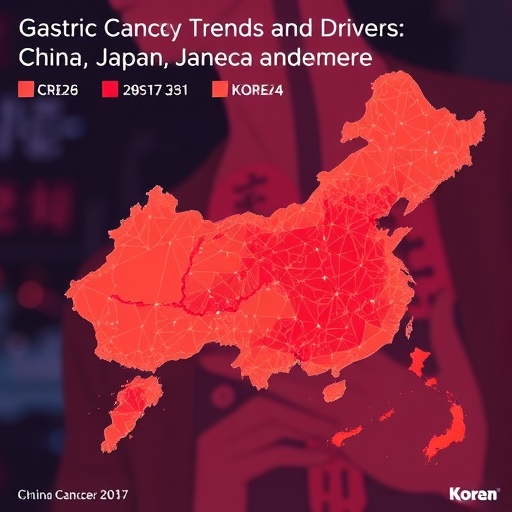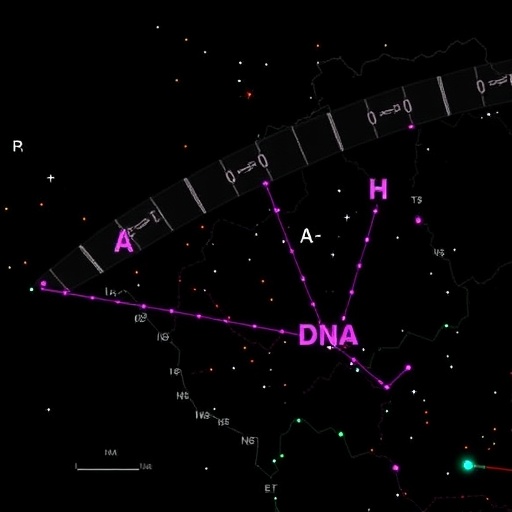Gastric cancer (GC) continues to be a formidable global health challenge, representing one of the most prevalent and deadly malignancies worldwide. Despite considerable progress in early detection methods and therapeutic interventions, its incidence and mortality remain alarmingly high, particularly across East Asia. The latest comprehensive study published in BMC Cancer offers a landmark comparative analysis focusing on China, Japan, and South Korea—three countries exhibiting some of the highest gastric cancer burdens globally. This research delves into epidemiological trends, underlying risk factors, and future projections with a sophisticated modeling approach, providing novel insights into the evolving landscape of this disease.
Central to this study is the interrogation of extensive data from the Global Burden of Disease (GBD) 2021 database, spanning three decades from 1990 to 2021. Utilizing this rich dataset, researchers mapped out the trajectories of age-standardized incidence rates (ASIR) and age-standardized mortality rates (ASMR) worldwide, with a granular focus on East Asia. The findings reveal a consistent and statistically significant global decline in both new cases and deaths from gastric cancer. Globally, the ASIR decreased from 24.76 per 100,000 person-years in 1990 to 14.33 in 2021, accompanied by a corresponding decline in ASMR from 22.01 to 11.20 per 100,000 person-years.
While the global trend is promising, regional disparities underscore a more complex epidemiological picture. China, for instance, has experienced a noteworthy reduction in incidence rates, with ASIR falling from 48.03 to 29.05 per 100,000 over the study period. However, this decline, although significant, is less steep compared to South Korea and Japan. Among the nations analyzed, South Korea shows the most dramatic improvement, evidenced by the ASIR plummeting from 71.18 to 25.76 per 100,000, suggesting the effectiveness of early screening programs and public health policies aggressively targeting GC risk factors. Japan similarly exhibits commendable progress, with ASIR declining from 64.05 to 25.54 per 100,000.
Underlying these epidemiological shifts are demographic and lifestyle factors that intricately shape the disease burden. The study’s decomposition analysis identifies population aging as the most influential driver contributing to the overall disease load. This is crucial because gastric cancer predominantly affects older adults, and aging populations tend to increase absolute case numbers even when age-specific incidence decreases. Such an interplay complicates simple interpretations of declining rates and emphasizes the need for health systems to prepare for an increased absolute number of cases due to demographic aging.
In tandem with age, behavioral and environmental risk factors heavily influence regional variations in gastric cancer rates. High dietary salt intake, a long-recognized carcinogen in stomach cancer etiology, remains widespread, particularly in traditional East Asian diets. Additionally, tobacco smoking persists as a potent risk factor, synergistically exacerbating the cancer burden. The study underlines how sustained public health efforts focusing on reducing smoking prevalence and dietary salt consumption could yield substantial gains in mitigating the disease’s impact.
Notably, the researchers applied the Bayesian Age-Period-Cohort (BAPC) model to forecast future trends in gastric cancer burdens. This sophisticated statistical approach accounts for temporal shifts related to aging, birth cohorts, and periods, providing more nuanced projections that can inform policy and clinical planning. The forecasts suggest that, despite continued declines in incidence rates, the absolute number of cases might stabilize or potentially increase in certain regions due to demographic patterns, necessitating sustained vigilance in public health strategies.
The study’s comprehensive comparative perspective between China, Japan, and South Korea highlights the heterogeneous nature of gastric cancer burden reduction across these countries. The variance in disease dynamics likely reflects differences in healthcare infrastructure, screening program coverage, population genetics, socioeconomic factors, and the pace of lifestyle changes. South Korea’s remarkable progress is often attributed to its nationwide screening program, which emphasizes early detection and eradication of Helicobacter pylori infection, a crucial factor in the pathogenesis of gastric cancer.
Moreover, the study brings to light the essential role of health interventions tailored to specific regional contexts. For countries like China, where the burden remains comparatively high, increased investment in early screening and public health campaigns targeting modifiable risk factors could expedite reductions. The integration of genomic and molecular epidemiology with traditional surveillance promises to deepen understanding of gastric cancer heterogeneity and improve precision medicine approaches.
The findings also raise important questions about healthcare equity and access. Variations in gastric cancer outcomes may be influenced by disparities in socioeconomic status, urbanization, and health literacy. Addressing these challenges requires a multifaceted approach that encompasses education, infrastructure improvement, and equitable provision of preventative and therapeutic services. The interplay of social determinants with biological risk factors underscores a complex landscape necessitating collaborative international efforts.
Importantly, the study reiterates the global shift in the etiology of gastric cancer, moving from proximal to distal stomach cancers, linked to changing lifestyle and environmental exposures. This epidemiological transition impacts screening strategies and therapeutic approaches, emphasizing the dynamism of gastric cancer as a public health problem. Understanding these trends ensures that health policies remain adaptive and evidence-based.
The role of Helicobacter pylori as a primary causal agent remains central to gastric carcinogenesis. The study indirectly supports continued emphasis on H. pylori eradication, especially in high-prevalence areas, as a foundational preventive measure. Such targeted interventions, combined with lifestyle modifications, could potentially reshape the future burden of gastric cancer and reduce its global mortality.
In light of the study’s projections, health authorities and policymakers face the dual challenge of sustaining gains in incidence reduction while managing the growing needs of aging populations. Integration of advanced diagnostic technologies, including biomarkers and imaging modalities, into routine screening could enhance early detection rates and improve patient outcomes. Additionally, leveraging artificial intelligence and machine learning to analyze vast epidemiological data may offer new avenues for predictive modeling and individualized risk assessment.
The research advances the scientific community’s understanding of the intertwined roles of demographic shifts, behavioral risks, and healthcare interventions in modulating gastric cancer burden. It underscores the global benefit of cross-national research collaborations that harness data harmonization and advanced modeling frameworks. Such synergistic efforts are essential to devise innovative strategies that can counteract this disease’s persistent threat.
Ultimately, this study serves as a clarion call for sustained, multifaceted public health action aimed at reducing gastric cancer incidence and mortality. Continued investment in screening infrastructure, widespread implementation of lifestyle interventions, and targeted eradication of microbial risk factors hold promise for transforming the gastric cancer landscape in East Asia and beyond. As nations grapple with demographic transitions and evolving environmental exposures, the insights provided here chart a clear path toward more effective disease control.
This rigorous epidemiological analysis serves not only as an academic benchmark but also as a practical guide for clinicians, policymakers, and researchers committed to combating one of the world’s most stubborn cancers. The convergence of data-driven techniques and actionable public health knowledge exemplifies the future of cancer epidemiology and control in the 21st century.
Subject of Research: Epidemiology, Burden, and Predictive Modeling of Gastric Cancer in East Asia
Article Title: Burden, trends, driving factors, and predictions of gastric cancer: a cross-national comparative analysis of China, Japan, and South Korea
Article References:
Liu, W., Peng, Zz., Zhang, T. et al. Burden, trends, driving factors, and predictions of gastric cancer: a cross-national comparative analysis of China, Japan, and South Korea. BMC Cancer 25, 1669 (2025). https://doi.org/10.1186/s12885-025-15009-8
Image Credits: Scienmag.com
DOI: https://doi.org/10.1186/s12885-025-15009-8
Tags: age-standardized incidence rates of gastric cancercomparative analysis of gastric cancer in East Asiaearly detection methods for gastric cancerepidemiological analysis of gastric cancerfuture projections for gastric cancergastric cancer mortality rates in Chinagastric cancer trends in East Asiaglobal burden of disease 2021 studyJapan and Koreapublic health challenges of gastric cancerrisk factors for gastric cancertherapeutic interventions for gastric cancer





